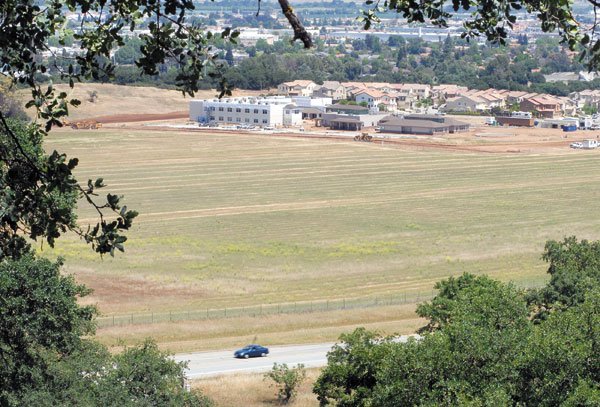When a new elementary school opens this fall in southwest
Gilroy, none of the students will come from the 2,100 homes it was
meant to serve. Problem is, none of the homes exist.
Gilroy – When a new elementary school opens this fall in southwest Gilroy, none of the students will come from the 2,100 homes it was meant to serve. Problem is, none of the homes exist.
Owners of west Gilroy land along Hecker Pass Highway and Santa Teresa Boulevard have delayed construction as they wait for the real estate market to regain its sizzle. And that waiting game, permitted under development deals struck by City Hall, is wreaking havoc on the school district’s budget and its efforts to plan for new facilities. Both the city and cash-strapped school district finance new buildings with millions of dollars in fees generated from new development.
“(By this fall), we will have built the equivalent of $60 million worth of schools without any impact fees coming from either project,” said Steve Brinkman, assistant superintendent for the Gilroy Unified School District.
Ascencion Solorsano Middle School was completed in 2002 amidst the rolling hayfields of Glen Loma Ranch, the future home of 1,693 homes in the city’s southwest quadrant. This fall, the new Las Animas Elementary School will open less than a mile to the south.
“We have two schools built servicing a major subdivision which has yet to construct one home,” Brinkman said.
“The biggest thing is the flexibility that (developers are) given,” he added. “It makes it very difficult for us to plan and deliver schools when the needs exist, and also creates an uncertainty and complexity regarding funding, so that the two might not align. More often than not, they don’t.”
The disconnect may persist for several years as Glen Loma Group, which represents the 100-plus members of the Filice family with stakes in the 359-acre Glen Loma property, puts off construction for several years. The city granted Glen Loma added flexibility in its construction timeline in a 2005 development agreement.
In exchange for agreeing to build a new fire station, public parks and other items on the city’s wish-list of projects for the area, Glen Loma received permission by the city council to fast-track or postpone development by three years. Wiggle room on construction permits is typically no more than one year on either side of the permit date. Under the original timetable, Glen Loma was scheduled to have built nearly 300 homes by the end of 2007.
“We sell fully approved lots to merchant builders, and the builders who are in the market right now are what are called bottom feeders,” said Tim Filice, a family representative who has worked on the project for nearly a decade. “They’re looking for bargains and we’re not in a position where we have to do that. We just have not consummated any deals. Most of the builders with whom we’ve done work in the past are looking toward the 2008 and 2009 time frame. We pretty much react to that, so we’re basically on the shelf right now.”
Hecker Pass landowners who have permission to build 427 homes in the next five years are following suit. They too negotiated three-year flexibility in a development agreement with City Hall. Construction on the first 71 homes along Hecker Pass was scheduled to begin this year.
“We’re still going through the process of deciding whether or not we want to start now or hold for a bit,” landowner Chris Vanni said in early May. “We are kind of working through the process.”
The development slowdown comes during a natural pause in the city’s construction cycle, but the Gilroy Unified School District has not been so fortunate.
Delays pose a double-whammy for a district saddled with $13 million in debt. The development stall not only prevents the district from starting to collect an estimated $12.5 million in fees, but the lack of new students prevents school officials from raising those fees to better finance new facilities. A rising student population, as measured by actual growth and not just projected growth, is a key factor in justifying higher fees under state regulations.
“In general, the school district is not a party to the development agreements, but it has to deal with any of the consequences,” Brinkman said. “For instance, if a development agreement provides a certain schedule and allows flexibility to move the development back or forward, that makes it very difficult for the school district to plan new facilities.”
City officials say they keep the school district apprised of any movement on development projects, and that in absolute terms, the city hasn’t pulled any punches.
“The total number (of homes) … isn’t anything new,” City Administrator Jay Baksa said. “The school district knows what is (permitted). Their conversation may be more about the flexibility of the window.”
“We’ve been talking about this for years,” Baksa added. “The system they have to work under is so difficult that there really isn’t any action we can take that helps them directly.”
City council has refused to take extreme measures such as declaring a building moratorium, opting instead to help the school district convince developers to voluntarily cough up cash or offer other assistance. A first draft of a plan developers helped craft will be discussed Monday, though all but two of seven school board trustees will be out of town on a site visit for a new superintendent.
If developers hold off on construction until the next housing boom, the city could see up to 1,400 homes built in as short as two years. Past construction spikes have meant hiring extra building inspectors and engineers, though it has not led to a “bottleneck” on roads, sewer lines and other infrastructure. Such basic infrastructure, Baksa said, speeds up or slows down in step with home construction and the fees it generates.
Though several years of major construction have drained funds supported by development fees, the city is headed into a quiet phase of construction.
“So we were a bit lucky with the timing of this,” Baksa said. “But if this continues over the next few years, we may have to delay projects. If you’re not getting the money in, you can’t get it out.”
The fate of the city and school district lies with the housing. In April, the median home price in Gilroy was $685,000, down just $5,000 from the same time last year. But homes are taking weeks or months longer to sell this season than in recent years, and it remains unclear if that trend will change any time soon. There will be no significant up-tick in single-family home sales until the second half of 2008, according to an April forecast from the National Association of Realtors.
“I like to be an optimist, and they’re saying that…things will get better,” said Susan Jacobsen, a real estate agent with Starritt Realty.
“I had more people at an open house Sunday than I’ve had in a long time,” she said, adding: “Interest rates are good … Buyers, what are you waiting for?”















